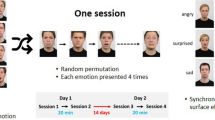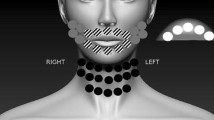Abstract
Multichannel integrated action-potential recordings (called electromyometrograms or EMMGs) from 10 individuals with various functional symptoms and disorders were selected for statistical examination to obtain evidence bearing on the topic in question. Each EMMG recorded the action-potential levels from four regions simultaneously via four channels of integrating differential amplifiers. The subjects sat quietly, awake and alert, with eyes open and head erect. Electrodes were placed over antagonistic muscle groups in the following regions: (1) forehead, (2) jaw-throat, (3) right forearm, (4) left leg. Successive 1-minute action-potential levels from each of these regions were used to calculate within-subject correlations (r) and predictabilities (r 2 andR 2) among the different regions. Mean and median correlations (r) and predictabilities (r 2 andR 2) for each of the following pairs of regions were found to be weak: (1) forehead and jaw-throat, (2) forehead and forearm, (3) forehead and leg, (4) jaw-throat and forearm, (5) jaw-throat and leg, (6) forearm and leg. The findings support the statement that the frontalis or any of the other regions measured are poor indicators of the amount of activity elsewhere in the skeletal musculature of awake and alert individuals. When combined with basic principles of neuroanatomy and neurophysiology, the findings also support the statement that there is probably no portion of the skeletal musculature that can be used to quantify the activity in other portions.
Similar content being viewed by others
References
Alexander, A. B. An experimental test of assumptions relating to the use of electromyographic biofeedback as a general relaxation training technique.Psychophysiology 1975,12 656–662.
Freedman, R.Generalization of frontalis EMG biofeedback training to other muscles. Paper presented at the 7th annual meeting of the Biofeedback Research Society, Colorado Springs, February 27–March 2, 1976.
Glaus, K. D., & Kotses, H.Generalization of frontalis muscle tension. Paper presented at the 8th annual meeting of the Biofeedback Society of America, Orlando, March 4–8, 1977.
Shedivy, D. I., & Kleinman, K. M. Lack of correlation between frontalis EMG and either neck EMG or verbal ratings of tension.Psychophysiology 1977,14 182–186.
Stoyva, J. Self-regulation and the stress-related disorders: A perspective on biofeedback. In D. Mostofsky (Ed.),Behavior control and modification of physiological activity. New York: Appleton-Century-Crofts, 1976.
Whatmore, G. B., & Ellis, R. M., Jr. Some motor aspects of schizophrenia: An EMG study.American Journal of Psychiatry 1958,114 882–889.
Whatmore, G. B., & Ellis, R. M., Jr. Some neurophysiologic aspects of depressed states: An electromyographic study.Archives of General Psychiatry 1959,1 70–80.
Whatmore, G. B., & Kohli, D. R. Dysponesis: A neurophysiologic factor in functional disorders.Behavioral Science 1968,13 102–124.
Whatmore, G. B., & Kohli, D. R.The physiopathology and treatment of functional disorders. New York: Grune and Stratton, 1974.
Author information
Authors and Affiliations
Additional information
We express our appreciation to each of the following individuals: Theodore C. Ruch, Ph.D., executive officer of the Department of Physiology and Biophysics at the University of Washington, for giving the assistance of his electronics engineering staff, John W. Dudley, Richard M. Ellis, Jr., and Dean Franklin, in the design and construction of equipment; Robert J. Kohlenberg, Ph.D., associate professor of psychology at the University of Washington, and David B. Whatmore, undergraduate student, for critically reading the manuscript and making valuable suggestions; and Clark R. Thompson, graduate student at the University of Washington, for assisting in some of the computer analyses and also for reading the manuscript and making valuable suggestions.
Rights and permissions
About this article
Cite this article
Whatmore, G.B., Whatmore, N.J. & Fisher, L.D. Is frontalis activity a reliable indicator of the activity in other skeletal muscles?. Biofeedback and Self-Regulation 6, 305–314 (1981). https://doi.org/10.1007/BF01000656
Issue Date:
DOI: https://doi.org/10.1007/BF01000656




